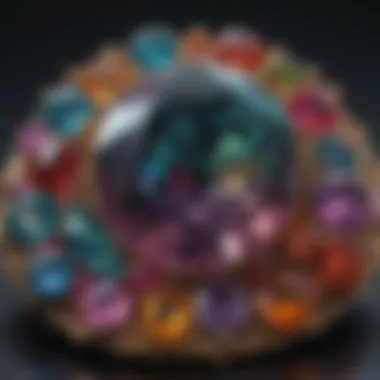Unlocking the Mysteries of Gemstones: An Expert Guide to Identification


Overview of Gemstones and Minerals
Gemstones have held a captivating allure throughout history, deeply intertwined with human culture and society. The use of gemstones and minerals dates back centuries, playing significant roles in various civilizations and cultural practices. From ancient civilizations using gems for adornment and religious ceremonies to modern-day jewelry design and healing practices, the history of gemstones and minerals is laden with symbolism and significance.
Gemstone Formation and Properties
The formation process of gemstones is a fascinating journey that spans millions of years. Gemstones are created deep within the Earth's crust under immense pressure and temperature conditions, resulting in the formation of crystalline structures with unique properties. Each gemstone is characterized by specific properties such as color, hardness, and luster, which play a crucial role in identifying and categorizing them within the mineral kingdom.
Types of Gemstones
Diving into the realm of gemstones reveals a diverse array of varieties, each with its own allure and mystique. Understanding the distinction between precious and semi-precious gemstones is essential, as it directly influences their scarcity and value in the market. Common gemstone varieties range from popular gems like diamonds and sapphires to lesser-known beauties like peridots and garnets. For enthusiasts seeking the rare and exotic, there exist gems with limited availability and exceptional beauty that capture the imagination of collectors worldwide.
Identifying and Evaluating Gemstones
Evaluating gemstones involves a meticulous assessment of various factors that contribute to their value and quality. From color intensity and clarity to size and cut, each element influences the overall worth of a gemstone. Adopting advanced techniques for gemstone identification, including spectroscopy and gemological tools, is crucial in accurately assessing the authenticity and quality of precious stones. By mastering the art of gem evaluation, enthusiasts can confidently navigate the world of gemstones with discerning eyes.
Caring for Gemstones
Proper care and maintenance are essential to preserving the beauty and value of gemstones. Knowing how to clean and store gemstones effectively prevents damage and ensures their longevity. Avoiding common mistakes, such as exposing gemstones to harsh chemicals or storing them improperly, safeguards their brilliance and luster. Additionally, understanding specific preservation tips for different gem types, from emeralds to opals, enhances the longevity of these precious treasures, allowing them to be passed down through generations with their natural splendor intact.
Introduction
Gemstones have a long-standing allure that captivates enthusiasts and collectors worldwide. In this comprehensive guide to precious stone identification, we delve into the intricate world of gems, unraveling their unique characteristics, formation processes, and historical significance. By immersing ourselves in the realm of gemology, we pave the way for a deeper understanding and appreciation of these natural treasures. Whether you are a seasoned jewelry designer, a passionate gemstone enthusiast, or a curious geology buff, this guide is tailored to enrich your knowledge and sharpen your discerning eye for gemstone identification.
Understanding Gemstones
What Makes a Gem Precious
Exploring the depths of what makes a gem precious unveils a myriad of factors that contribute to a stone's allure. Beyond their aesthetic appeal, gemstones are revered for their rarity, durability, and distinct optical properties. The intrinsic beauty of gems lies in their ability to refract and reflect light in mesmerizing ways, captivating the beholder with their brilliance. Understanding the geological conditions that gave rise to these precious stones sheds light on their significance in the world of jewelry and history. The enduring charm of gemstones as symbols of luxury and status intertwines with their profound cultural and metaphysical symbolism, making them timeless treasures coveted across civilizations.
The Significance of Gemstones in History
Tracing the historical tapestry of gemstones unravels a rich narrative entwined with legends, folklore, and legacy. Throughout history, gemstones have symbolized power, protection, and beauty, adorning royalty, nobility, and deities alike. From ancient civilizations to modern-day empires, the allure of gemstones transcends time, shaping cultural practices, trade routes, and belief systems. Their intrinsic value extends beyond monetary worth, encompassing spiritual, healing, and mystical properties that have stood the test of time. Delving into the historical significance of gemstones unravels a tapestry of human creativity, tenacity, and reverence for the natural world.
Importance of Stone Identification


Value of Identifying Gemstones Accurately
Precise identification of gemstones holds intrinsic value for gemologists, jewelry connoisseurs, and consumers alike. Accurate gemstone identification ensures transparency in trade, authenticity in jewelry creation, and informed decision-making for buyers. The ability to discern between natural gemstones, synthetics, and imitations safeguards against fraud and underscores the integrity of the gemstone industry. A trained eye for gemstone characteristics, coupled with scientific testing methods, forms the bedrock of gemstone identification, paving the way for a trustworthy and ethical gem trade.
Benefits of Knowing the Properties of Gemstones
Delving into the properties of gemstones unlocks a treasure trove of knowledge that transcends mere aesthetics. By understanding the chemical composition, crystal structure, and optical phenomena exhibited by gemstones, enthusiasts gain a profound appreciation for their diversity and allure. Knowledge of gemstone properties guides the cutting, setting, and care procedures essential for preserving their beauty and durability. Moreover, the ability to differentiate between gem varieties based on their unique properties empowers collectors and designers to curate distinctive pieces that reflect their vision and creativity. Embracing the intricacies of gemstone properties enhances the joy of discovery and fuels a lifelong passion for these captivating geological marvels.
Characteristics of Gemstones
When delving into the world of gemstones, understanding their characteristics is paramount. This section of the comprehensive guide serves as a lens through which to view the intricacies that define these prized beauties. Examining the color, clarity, transparency, cut, shape, and carat weight of gemstones not only enhances the ability to identify them but also deepens one's appreciation for their unique allure. Each characteristic plays a crucial role in distinguishing one gem from another, reflecting its rarity, value, and aesthetic appeal.
Color
Gemstone color is a defining feature that captures the eye and elicits emotions. The impact of color on gemstone identification cannot be overstated. Whether it's the intense red of a ruby, the deep blue of a sapphire, or the vivid green of an emerald, color sets the tone for a gemstone's identity. Understanding how different hues can affect the perceived quality and value of a gemstone is essential for gem enthusiasts. The rarity of unique colored gems adds an element of exclusivity and allure to a collection, making them highly sought after by connoisseurs.
Clarity and Transparency
The clarity and transparency of a gemstone provide insights into its quality and formation. Determining clarity levels involves assessing the presence of inclusions or imperfections that may impact the gem's appearance and value. Alternatively, transparency plays a key role in how light interacts with the gem, affecting its brilliance and overall aesthetic. Recognizing the significance of transparency in gemstones aids in appreciating their inner world, revealing glimpses of their inner beauty.
Cut and Shape
Gemstone cuts are not merely about shaping the stone but are a reflection of the lapidary's skill and artistry. Popular gemstone cuts such as round brilliant, princess, and emerald cuts showcase a gem's brilliance and fire, enhancing its visual appeal. The impact of cutting on gem appearance underscores the importance of precision in enhancing a stone's natural beauty. Whether it's a radiant cut diamond or a cushion cut sapphire, the choice of cut influences how light interacts with the gem, elevating its overall allure.
Carat Weight
Understanding carat weight goes beyond numeric value; it signifies a gemstone's size and presence. The relationship between carat weight and value is not linear but influenced by factors such as rarity and demand. While larger carat gemstones may command attention, smaller carat stones can possess unique characteristics that make them equally desirable. Detailed knowledge of carat weight in gemstones empowers collectors and buyers to make informed decisions regarding the stones they acquire. Exploring the intricate nuances of carat weight enhances one's appreciation for the multifaceted world of gemstones.
Gemstone Identification Methods
Gemstone identification methods are paramount in the realm of gemology, playing a crucial role in accurately discerning precious stones. These methods encompass various techniques that aid gemologists in determining the authenticity and properties of gemstones. By utilizing a combination of physical observations and specialized tools, gemstone identification methods facilitate the classification and appraisal of gemstones with precision. The meticulous application of these methods ensures that gem enthusiasts, collectors, and industry professionals can confidently assess the value and quality of gemstones in their possession.
Physical Properties
Use of Hardness Scale for Identification
The utilization of a hardness scale for gemstone identification is a fundamental aspect of gemology. The Mohs hardness scale, developed by Friedrich Mohs in 1812, ranks minerals based on their scratch resistance against other materials. This scale is integral in distinguishing gemstones and assessing their durability. By systematically testing the hardness of a gemstone against known minerals, gemologists can ascertain the relative hardness of the gem, providing valuable insights into its wearability and susceptibility to damage. The hardness scale serves as a reliable tool in gemstone identification, offering a standardized method to evaluate the physical strength of different gem types.


Assessing Refractive Index
Measuring the refractive index of gemstones is a critical component of gemological analysis. The refractive index refers to the speed of light as it travels through a gemstone, influencing the gem's brilliance and optical properties. By determining the refractive index, gemologists can identify gemstones based on their unique light-handling characteristics. Variances in refractive index aid in distinguishing gem types and separating natural gems from synthetic counterparts. This method enables gem enthusiasts to recognize the optical purity and authenticity of gemstones, contributing to a comprehensive gemstone identification process.
Gemological Tools
Loupe and Microscope Usage
The utilization of loupes and microscopes is imperative in gemstone identification, allowing gemologists to examine gems at magnified levels and assess their minute details. Loupes provide a close-up view of gemstone inclusions, color zoning, and surface features, aiding in the verification of gem authenticity. Microscopes offer enhanced magnification capabilities, enabling thorough inspections of a gem's internal structure and clarity characteristics. The combined use of loupes and microscopes ensures meticulous scrutiny of gemstones, enabling precise identification and evaluation based on visual cues and optical properties.
Importance of Spectroscope in Gem Identification
The spectroscope is a vital tool in gem identification, enabling gemologists to analyze the spectral fingerprints of gemstones. By observing the absorption and emission lines in the gem's spectrum, gemologists can identify unique absorption patterns that correspond to specific gem types. The spectroscope aids in differentiating natural gemstones from treatments or enhancements, providing insights into the gem's origin and geological history. This tool is indispensable in confirming the authenticity and quality of gemstones, enhancing the accuracy of gemstone identification processes.
Testing Techniques
Specific Gravity Test
The specific gravity test is a fundamental technique in gemology, which involves measuring the density of a gemstone compared to water. This test aids in determining the authenticity of gemstones and differentiating between various gem materials with similar appearances. By assessing the weight-to-volume ratio of a gemstone, gemologists can deduce its composition and potential treatments. The specific gravity test offers valuable information on a gem's physical properties, allowing gem enthusiasts to make informed decisions regarding gemstone identification and classification.
Thermal Conductivity Assessment
Assessing the thermal conductivity of gemstones plays a crucial role in gem identification processes, particularly in distinguishing natural gems from their synthetic counterparts. Gemologists utilize thermal conductivity tests to evaluate how efficiently heat transfers through a gemstone, providing insights into its material composition and authenticity. Variations in thermal conductivity assist gemologists in detecting treatments, enhancements, or imitations in gemstones, ensuring accurate identification and appraisal. This testing method enhances the reliability and precision of gemstone identification, enabling gem enthusiasts to delve deeper into the world of precious stones.
Common Gem Types
Gemstones come in a variety of types and have long fascinated collectors, jewelry designers, and geology enthusiasts alike. Understanding common gem types is crucial in the world of precious stone identification as it forms the foundation of gemology. When delving into the realm of gemstones, one must explore the distinguishing features, rarity, and significance of each gem type to truly appreciate their beauty and value.
Diamond
The 4Cs of Diamond Evaluation
In the world of diamonds, the 4Cs—cut, color, clarity, and carat weight—serve as the cornerstone for evaluating a diamond’s quality and value. The precise cut of a diamond determines its brilliance and fire, while color grading examines the presence of any tint in the stone, with colorless diamonds being the most coveted. Clarity assesses the presence of imperfections or inclusions, impacting the stone's transparency and brilliance. Carat weight, on the other hand, signifies the size and weight of the diamond, influencing its overall value and rarity.
Identifying Synthetic Diamonds
Identifying synthetic diamonds is a crucial aspect of gemstone identification, especially in today's market where lab-created diamonds have become increasingly prevalent. The key to distinguishing synthetic diamonds lies in their growth characteristics, such as consistent color zoning or specific inclusions that differ from natural diamonds. Understanding these unique features enables gemologists to differentiate between natural and synthetic diamonds accurately, ensuring the integrity of the gem market.


Ruby and Sapphire
Distinguishing Ruby from Sapphire
Distinguishing between rubies and sapphires is essential due to their similar chemical composition and color variations. Rubies, commonly known for their rich red hue, belong to the corundum family, while sapphires encompass all other colors of corundum, including blue, pink, yellow, and more. By examining factors like color intensity, pleochroism, and inclusions, gemologists can accurately identify whether a stone is a ruby or a sapphire, allowing for precise gemstone classification.
Star Ruby and Star Sapphire Identification
Star rubies and star sapphires exhibit a captivating asterism phenomenon, where a star-shaped light reflection appears on the stone's surface. This optical effect is highly sought after by collectors and enthusiasts, adding to the allure of these gemstones. Identifying these unique characteristics, such as the number of rays in the star or the intensity of the phenomenon, enhances the appreciation and value of star rubies and sapphires in the gem market.
Emerald
Identifying Natural vs. Treated Emeralds
Distinguishing between natural and treated emeralds requires a keen eye for detail and knowledge of common enhancement techniques. Natural emeralds often contain inclusions that indicate their authenticity, while treated emeralds may exhibit clarity characteristics that are uncommon in natural stones. By evaluating color consistency, clarity features, and origin information, gemologists can discern between natural emeralds and those that have undergone treatment, providing consumers with transparent and accurate gemstone options.
Inclusions in Emeralds
Inclusions are a defining feature of emeralds, known for their unique garden-like patterns formed by mineral inclusions and fractures within the stone. These inclusions, such as fissures or liquid-filled cavities, add character and individuality to each emerald, contributing to its authenticity and beauty. Understanding the nature and impact of these inclusions enhances the appreciation of emeralds while also aiding in their identification and evaluation.
Pearl
Differentiating Natural Pearls from Cultured
Distinguishing between natural and cultured pearls involves examining various internal and surface characteristics of the pearl. Natural pearls form organically inside oysters without human intervention, displaying irregularities in shape and texture. In contrast, cultured pearls are cultivated through a controlled process that results in spherical shapes and uniform luster. By analyzing features such as nacre thickness, overtone hues, and surface quality, gemologists can identify whether a pearl is natural or cultured, preserving the integrity and value of these exquisite organic gems.
Luster and Surface Examination
Luster, defined as the shine or glow of a pearl’s surface, plays a significant role in assessing its quality and value. A pearl’s luster is influenced by the thickness and composition of its nacre layers, with a mirror-like sheen indicating superior quality. Surface examination involves scrutinizing the pearl's surface for imperfections, blemishes, or irregularities that may affect its appearance and desirability. By evaluating luster and surface characteristics, gemologists can discern the beauty and authenticity of pearls, making informed decisions based on their quality and visual appeal.
Conclusion
In the realm of gemstone identification, the conclusion serves as a vital segment encapsulating the essence of this comprehensive guide on precious stone identification. By delving into the intricate world of gemology, readers are equipped with a profound understanding of the principles and practices required to discern and appreciate these natural marvels. The importance of the conclusion lies in its ability to reinforce the significance of continuous learning in gemology and the deep-rooted appreciation for the beauty of gemstones.
Mastering the Art of Precious Stone Identification
Continuous Learning in Gemology
The facet of continuous learning in gemology plays a fundamental role in honing one's skills in identifying and appreciating precious gemstones. Emphasizing the perpetual evolution of knowledge and techniques in gemology, continuous learning ensures that enthusiasts stay abreast of the latest developments in gemstone identification. The key characteristic of continuous learning lies in its dynamic nature, where adaptability and openness to new information are paramount. This constant quest for knowledge is a beneficial choice for this guide as it underscores the necessity for gemstone enthusiasts to remain curious and receptive to new advancements. Continuous learning stands as a unique feature in this article, offering readers the opportunity to expand their expertise and refine their gemological skills continually.
Appreciation for the Beauty of Gemstones
An essential aspect of precious stone identification is developing a profound appreciation for the innate beauty of gemstones. Appreciating the beauty of gemstones goes beyond their monetary value, enriching the sensory experience and personal connection with these natural wonders. The key characteristic of this appreciation lies in the ability to transcend the material aspect of gemstones and delve into their aesthetic allure and symbolic significance. This appreciation enhances the overall goal of this guide by fostering a deeper connection between gem enthusiasts and the precious stones they encounter. The unique feature of appreciating the beauty of gemstones is the emotional depth it adds to gemological pursuits, allowing individuals to derive both visual and spiritual pleasure from these timeless treasures.







